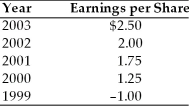Multiple Choice
A firm has had the following earnings history over the last five years:  If the firm's dividend policy was to pay $0.25 per share each period except when earnings exceed $1.50, when an extra dividend equal to 50 percent of the earnings above $1.50 would be paid, the annual dividends for 2000 and 2003 were
If the firm's dividend policy was to pay $0.25 per share each period except when earnings exceed $1.50, when an extra dividend equal to 50 percent of the earnings above $1.50 would be paid, the annual dividends for 2000 and 2003 were
A) $0.25 and $1.25, respectively.
B) $0.25 and $0.75, respectively.
C) $0 and $0.25, respectively.
D) $0.25 and $0.25, respectively.
Correct Answer:

Verified
Correct Answer:
Verified
Q30: The residual theory of dividends implies that
Q33: The problem with a constant-payout-ratio dividend policy
Q34: The factors involved in setting a dividend
Q36: The level of dividends a firm expects
Q37: In general, with regard to dividend payments,
Q38: The bird-in-the-hand argument espousing the importance of
Q39: A firm that has a large percentage
Q40: The representative theory of dividends, as espoused
Q53: If a firm has overdue liabilities or
Q59: By purchasing shares through a firm's dividend